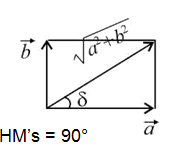The displacement of a particle varies with time according to the relation y=asinωt+bcoasωt.
The motion is S.H.M. with amplitude a2+b2
The motion is S.H.M. with amplitude a+b
The motion is S.H.M. with amplitude a2+b2
The motion is S.H.M. with amplitude √a2+b2
The correct Answer is:D
We can write
y=√a2+b2sin(ωt+Δ)
where tanΔ=ba.

Topper's Solved these Questions
- SIMPLE HARMONIC MOTION BOOK - VMC MODULES ENGLISHCHAPTER - SIMPLE HARMONIC MOTION EXERCISE - LEVEL (2)
40 Videos
- SIMPLE HARMONIC MOTION BOOK - VMC MODULES ENGLISHCHAPTER - SIMPLE HARMONIC MOTION EXERCISE - 6-previous year question
56 Videos
- SIMPLE HARMONIC MOTION BOOK - VMC MODULES ENGLISHCHAPTER - SIMPLE HARMONIC MOTION EXERCISE - LEVEL 0 LONG ANSWER TYPE
2 Videos
- ROTATIONAL MOTION BOOK - VMC MODULES ENGLISHCHAPTER - ROTATIONAL MOTION EXERCISE - JEE Advanced (Archive) (True/False Type)
3 Videos
- SYSTEM OF A PARTICLES & ROTATIONAL MOTIONBOOK - VMC MODULES ENGLISHCHAPTER - SYSTEM OF A PARTICLES & ROTATIONAL MOTIONEXERCISE - IN-CHAPTER EXERCISE F
10 Videos
Similar Questions
Knowledge Check
The displacement of a particle varies with time according to the relation y=asinωt+bcosωt.
AThe motion is oscillatory but not SHM.BThe motion is SHM with amplitude a+b.CThe motion is SHM with amplitude a2+b2DThe motion is SHM with amplitude √a2+b2.
If the displacement of a particle varies with time as √x=t+3
View SolutionThe linear displacement (y) of a particle varies with time as y=(asinωt+bcosωt). State whether the particle is executing SHM or not.
View SolutionThe displacement of a particle varies according to the relation x=4(cosπt+sinπt). The amplitude of the particle is.
View SolutionThe acceleration of a particle varies with time t seconds according to the relation a=6t+6ms−2. Find velocity and position as funcitons of time. It is given that the particle starts from origin at t=0 with velocity 2ms−1.
View SolutionThe energy E of a particle varies with time t according to the equation E=E0sin(αt).e−αtβx, where x is displacement from mean position E0 is energy at infinite position and α and β are constants .
Dimensions of β are
View SolutionThe energy E of a particle varies with time t according to the equation E=E0sin(αt).e−αtβx, where x is displacement from mean position E0 is energy at infinite position and α and β are constants .
Dimensional formula of α is
View SolutionThe energy E of a particle varies with time t according to the equation E=E0sin(αt).e−αtβx, where x is displacement from mean position E0 is energy at infinite position and α and β are constants .
Dimensions of sin(αtβx) are
View Solution
